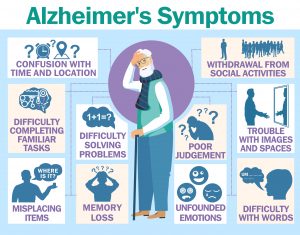Alzheimer’s Disease: Definition, Pathophysiology, Symptoms, Treatment and MCQs for NEET, GPAT, CSIR NET JRF
“Alzheimer is a neurological disorder which is irreversible, and destroy your memory and thinking ability, and eventually, to carry out your simple tasks.”
1.] The exact cause of Alzheimer’s disease is still unknown abut there are few factors that are implicated in its etiology like positive family history and deposition of Aβ amyloid derived from amyloid precursor protein (APP) forming neuritic ‘senile’ plaques and neurofibrillary tangles.
PATHOPHYSIOLOGY: –
- More than half of young-onset, dominantly inherited cases are attributed to alterations on chromosomes 1, 14, or 21. Genetic susceptibility to late-onset AD is primarily linked to the apolipoprotein E (APOE) genotype, but an interaction of multiple genes with the environment may be at play.
- Risk factors associated with AD include age, decreased reserve capacity of the brain, head injury, Down syndrome, depression, mild cognitive impairment, and risk factors for vascular disease, including hypertension, elevated low-density lipoprotein cholesterol, low high-density lipoprotein cholesterol, and diabetes.
- Signature findings include intracellular neurofibrillary tangles (NFTs), extracellular amyloid plaques in the cortex and medial temporal lobe, and degeneration of neurons and synapses and cortical atrophy. Density of NFTs correlates with severity of dementia.
- Proposed mechanisms for these changes include
- (1) β-amyloid protein aggregation, leading to formation of plaques;
- (2) Hyperphosphorylation of tau protein, leading to NFTs;
- (3) Synaptic failure and depletion of neurotrophin and neurotransmitters;
- (4) Mitochondrial dysfunction; and
- (5) oxidative stress.
- Of neurotransmitter deficits, loss of cholinergic activity is most prominent, and it correlates with AD severity. Cholinergic cell loss seems to be a consequence of AD pathology, not the cause of it.
- Other neurotransmitter considerations include the following:
- (1) Serotonergic neurons of the raphe nuclei and noradrenergic cells of the locus ceruleus are lost;
- (2) Monoamine oxidase type B activity is increased;
- (3) Glutamate pathways of the cortex and limbic structures are abnormal; and
- (4) Excitatory neurotransmitters, including glutamate, may be neurotoxic in AD.
SYMPTOMS: –
Following are the symptoms of Alzheimer’s disease: –
- Memory loss
- Aphasia (inability to understand or produce speech) which indicate severe cortical dysfunction
- Sometimes patients also become profoundly disabled, mute and immobile
- Confusion
- Inability to learn new things
- Difficulty in organizing thoughts
- Decreased logical thinking
- Difficulty in reading, writing and working with numbers

The above image is taken for education purpose only from urgentteam.com
TREATMENT: –
Following are drugs used in the treatment of Alzheimer’s disease:
- Donepezil (Aricept, Aricept OTD)
- Rivastigmine (Exelon, Exelon Patch)
- Galantamine (Razadyne, Razadyne ER)
- Memantine (Namenda, Namenda XR)
MULTIPLE CHOICE QUESTIONS: –
1.] Nucleus involved in Alzheimer’s disease?
a. Nucleus Basalis of meynert
b. Superior salivary nucleus
c. Ventromedial nucleus of thalamus
d. All of the above
2.] Which of the following is not a feature of Alzheimer’s disease?
a. Neurofibrillary tangles
b. Senile plaques
c. Amyloid angioplasty
d. Lewy bodies
3.] Neurofibrillary tangles are seen in?
a. Parkinsonism
b. Alzheimer’s disease
c. Multiple sclerosis
d. Perivenous encephalomyelitis
4.] One of the first symptom of Alzheimer’s disease is?
a. Memory loss
b. Insomnia
c. Skin infection
d. All of the above
5.] Dementia in an old man with senile plaques is usually associated with?
a. Alzheimer’s disease
b. Picks disease
c. Parkinson’s disease
d. All of the above
6.] When can a definite diagnosis of Alzheimer’s disease be made?
a. At the onset of Alzheimer’s
b. After the death of the patient
c. When all signs and symptoms are present
d. At the first sign of dementia
7.] Alzheimer’s can be cured if detected early?
a. True
b. False
8.] Alzheimer’s disease is considered a terminal illness?
a. True
b. False
9.] What is the greatest risk factor for Alzheimer’s disease?
a. Gender
b. Genetics
c. Ethnicity
d. Increased age
10.] Alzheimer’s disease can resemble the early stages of?
a. Schizophrenia
b. Parkinson’s disease
c. Multiple sclerosis
d. Down’s syndrome
SOLUTIONS: –
1.] (a) Nucleus basalis of meynert
2.] (d) Lewy bodies
3.] (b) Alzheimer’s disease
4.] (a) Memory loss
5.] (a) Alzheimer’s disease
6.] (b) After the death of patients
7.] (b)
8.] (a)
9.] (d) Increased age
10.] (b) Parkinson’s disease
List of Successful GPATINDIAN CANDIDATES
Participate in Online FREE GPAT TEST: CLICK HERE
Participate in Online FREE Pharmacist TEST: CLICK HERE
Participate in Online FREE Drug Inspector TEST: CLICK HERE
Participate in CSIR NET JRF Mock Test
REFERENCES: –
1.] Textbook of Pathology by Harsh Mohan; 7th edition; Page no.876 – 877.
2.] Robbin’s Basic Pathology; 5th edition; Page no.1329 – 1331.